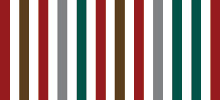
Image courtesy the Tropenmuseum
The exhibition Art of Survival: Maroon Culture from Suriname opened at the Tropenmuseum (Tropical Museum) in Amsterdam on 6 November, 2009, and runs until 9 May, 2010. Patricia Kaersenhout, an artist with Surinamese roots, based in Amsterdam, made the following notes after visiting the exhibition.
7 January, 2010
I do not have a love-hate relationship with the Tropenmuseum. On the contrary, I like spending hours there. Most of the time, the exhibitions are clear and the materials of high quality, sometimes shown with latest interactive stuff. Maybe I like it because it brings back a memory of the unknown.
In a way it reminds me of the covered tropical beach in Japan, complete with sunset, salt water, waves, sand, palm trees, and a horizon — but covered with a glass roof. An artificial world.
The Tropenmuseum represents an artificial tropical world which, to me — a child of immigrants from Suriname, but raised in a Western European climate — gives a bit of a sense of belonging. I only go there during the winter, when temperatures are low, skies are grey, and streets are wet.
The first thing I noticed entering Art of Survival was the overload of information. I immediately got discouraged, and had to supress the feeling to walk to the bookshop, buy the catalogue, walk to the restaurant, buy a coffee and sandwich, and start reading. I controlled myself, because I had a mission.
When there’s so much information, what sticks in your mind? Where to start? At the beginning, one might say — but it was not so clear where that was. Maybe it was of no importance. I just started somewhere. A touchscreen with a lot of videos and old photographs. The design of the video programme was very good. The explanation clear. It was easy to skip from one film to another. So as a viewer you’re not forced to see the whole film through. One could interrupt the film and go back and repeat an interesting scene.
After scrolling through some films, my eyes got captured by Obu/Wosu: A Life in French Guiana, by Felix de Rooy. The story tells about a Maroon sculptor, Kenneth Soleg Charvein, who lost most of his family at the tragedy of Moiwana. He talks about traditions in his work which he learned from his father. He prefers to work in a group of sculptors, because the world is bigger than we can imagine. “What you didn’t think of yourself will be created by the other.” Very impressive, because it’s in flat contradiction to the individualistic art tradition in which I was educated.
De Jongste Loot is a 1989 documentary by Frank Zichem. It tells the story of a soldier from the national army, Wigo Benton, who is captured by Ronnie Brunswijk. He is an eyewitness to some horrific events, and decides after he’s liberated to go to Holland. It turns out that he doesn’t exist there, because he doesn’t have official documents. One of the things he does to survive is listen to the birds and check if the soil of his little garden is fertile, so he can grow flowers and vegetables. Zooming in on his personal story penetrates the traumatic things that happened during that time in the interior of Suriname, deep in the consciousness of the viewer.
Next to many films and audio presentations, there were beautiful carved wood chairs and combs, woven cloths, and more objects which I won’t try to describe, because there were so many, and I have an ambivalent feeling about exhibiting utilitarian objects, even if they are from another culture. Even though they are well made, it seems rather odd to place them in a museum, looking at them with the serious eye of an interested visitor. Every culture has its right to privacy. I don’t like to peek into someone’s kitchen knowing that the other will never get a chance to see mine.
Among those objects which were supposed to give us an insight into daily life among the Maroons were two very strong artworks by Marcel Pinas. Here the exhibition shows its weakest point. Hanging contemporary art between arts and crafts just doesn’t work. I really like arts and crafts and I really like contemporary art. I just don’t want them to be shown together in such a way that they don’t uplift each other, but take each other down. Efforts to bring those two together often don’t do either of them any good. They are two disciplines which stand on their own. They can influence or inspire each other, but their approach in expression and ideas remains different.
Walking out of the museum, I was confronted by the exhibition poster on a billboard: an image of a black guy photographed half-faced. He’s wearing mirrored sunglasses. They reflect an image of trees and a river. I guess it’s in the interior of Suriname. To me it reflects a longing to be there. To flee from the hell of the European climate into a warm tropical paradise. A longing which Europeans have had since the fifteenth century. The paradox is that the Maroons have to “survive” in what we still see as paradise. But as soon as one has to survive instead of living one’s life, paradise is lost.
Video tour of Art of Survival, courtesy the Tropenmuseum
Notes: on Art of Survival
Monday, January 25, 2010
at 12:12 PM
Labels: de rooy, kaersenhout, maroon, notes, pinas, tropenmuseum, zichem
Subscribe to:
Post Comments (Atom)






0 comments:
Post a Comment